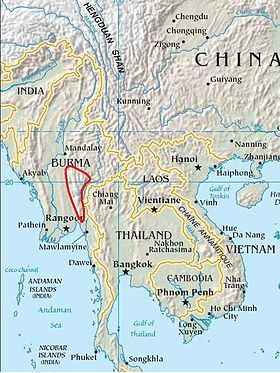Karen Hills
| Karen Hills | |
|---|---|

Location of the Karen Hills
|
|
| Highest point | |
| Peak | Nattaung |
| Elevation | 2,623 m (8,606 ft) |
| Coordinates | 18°49′N 97°2′E / 18.817°N 97.033°E |
| Geography | |
| Country | Burma |
| Range coordinates | 19°12′N 97°17′E / 19.2°N 97.28°ECoordinates: 19°12′N 97°17′E / 19.2°N 97.28°E |
| Parent range | Shan Hills |
| Geology | |
| Type of rock | Granite, limestone |
The Karen Hills, also known as Kayah-Karen Mountains, are one of the main hill ranges in eastern Burma. They are located at the SW corner of Shan State and in Kayah State, a mountainous region where the only relatively flat area is Loikaw, the capital. The southern end runs into Kayin State. One of the first all-weather roads in Burma was across the Karen Hills connecting Taungoo with Loilem.
Lawpita Falls, Myanmar's largest hydropower plant, built by the Japanese as war reparation, is located in these mountains.
The name of the range is derived from the Karen people who occupy the highland area. In colonial times these mountains were often referred to as the "Toungoo Hills", for they rise east of Taungoo (formerly "Toungoo").
Geographically the Karen Hills are the southwestern projection of the Shan Hills. The highest peak is Nattaung, one of the ultra prominent peaks in Southeast Asia. Another prominent mountain is 1,249 m high Takolaw Kyo.
The Karen Hills rise from Burma's central plain and stretch for 120 km eastwards in their broadest part until they reach the Salween (Thanlwin) River valley. The steep gorge of this river, one of the main rivers in Burma, divides the Karen Hills from the Dawna Range in the east.
The Karen Hills are covered with dense montane rain forest. Local villages used to be far up in the hills and as much off the main roads as possible and villagers used to cultivate upland rice in forest clearings. Owing to the activity of the Tatmadaw in the area many local people have moved across the border into Thailand where they live in refugee camps.
...
Wikipedia
